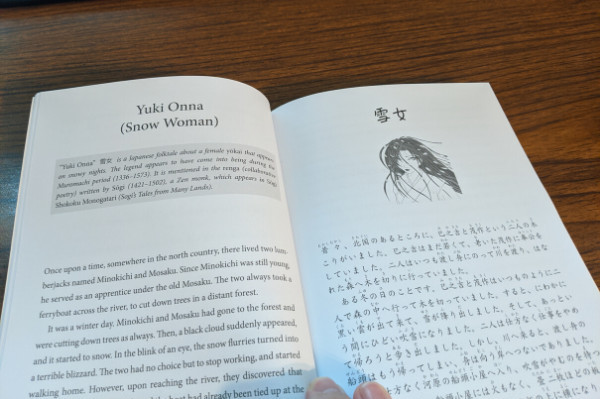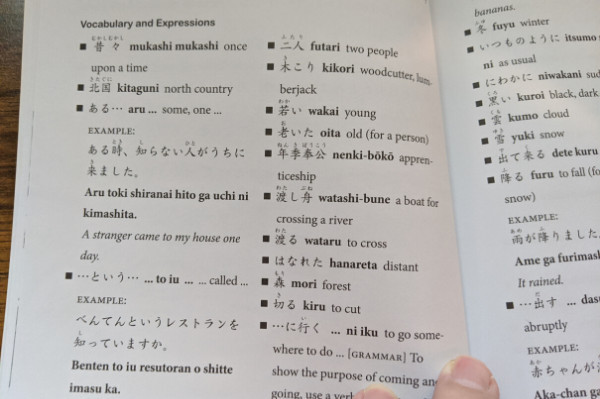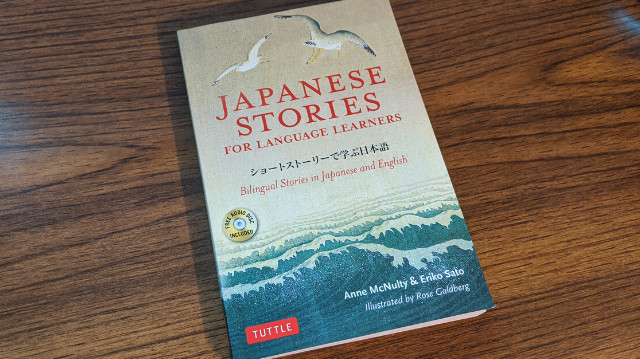The other day I was shopping on Amazon and they recommended a book to me. I picked it up and have really enjoyed is, so now I’m going to write a Japanese Stories for Language Learners review on it.
This book is a collection of Japanese short stories put into the format of a graded reader designed for people at the intermediate or advanced levels to use.
It’s got a lot of really cool things about it, so let me talk about those now.
The Five Stories
This book centers around five classic Japanese stories that people in Japan would know well. The first one is Urashima Taro who goes on an adventure to the dragon palace after rescuing a turtle from some kids who are bullying it.
The second story is The Snow Woman which is a kind of thriller that deals with the super natural and one man’s near death experience and subsequent life afterwards.
Both of these are fairly short reads and fall into the category of traditional folktales. The other three a noticeable longer and are actually drawn from modern Japanese literature.
The first in The Spider’s Thread is about the afterlife of a villain and explores the question of whether cold-blooded killers can have compassion for others hidden away in their hearts.
The next story is The Siblings Who Almost Drowned and it is thought that this tale comes from the actual life experiences of the author. It explores a question of going towards safety to save oneself or going towards danger to save someone else.
The last story is Gauche the Cellist and tells the story of a musician.
They are actually pretty good stories and the thing I like about them the most is that they are all written from Japanese authors.
I think that when possible, it’s a good idea to read books and stories that originate from Japan because it allows you to consume material that comes from a Japanese mind.
This helps you as a learner to see things the way Japanese people do and understand their viewpoints on various matters. Something that is harder to do when you read a book that has just been translated into the language from somewhere else.
English And Japanese Pages

This book is designed with the learner in mind and they make it easy to understand the words and phrases in several ways.
One huge way is by providing the same story in both Japanese and English. Of course the English translation is a “natural translation” of the sentences, so it’s not always going to line up 100% with the Japanese sentences, but I think that’s a good thing as it allows you to take more of a “big picture approach” to understanding the material
When you read the Japanese, every new kanji has furigana on it so that you can learn how to read it in that context, but then the next time you run into that kanji in the story it will be shown without any additional help.
I thought this was brilliant since it then forces you to recall how to say the word, which is a pretty good way to remember kanji readings.
There are two other things I want to mention about the stories, one big and one small.
The small thing is that there are some illustrations provided throughout each story that allow you to “see” what’s going on and really feel immersed in the stories. I thought that these were a great addition and I really enjoyed seeing them as I read.
The big thing is that an audio CD is included with a native speaker reading through the Japanese version of the stories. This is great since it allows you to not only listen to the stories, but to improve other aspects of your Japanese such as listening and pronunciation.
Even if you don’t have a CD player there’s no need to worry. The book provides a link that you can go to on your computer to download the mp3 audio files for free.
One thing that I’ll let you know about the audio is that the reader speaks at a speed that is appropriate for Japanese language learners. If you’re at an intermediate level, then you should be able to follow along without much of a problem.
On the other hand, if you’re at an advanced level with Japanese and you’re used to people speaking at a natural rate, then the speed will probably feel slow to you and you may not enjoy it.
Extensive Vocabulary Notes

This book really goes out of their way to provide you with information. At the end of each story there is a huge vocabulary and expressions section that almost every single Japanese word used in the story, its pronunciation in both hiragana and romaji, and then the English translation.
This allows you to take a detail oriented approach to learning Japanese since you see each sentence and word broken down piece by piece and explained.
In addition to just providing the English translation, the authors also provide some example sentences for more complicated words and grammar rules so that you can really get a good grasp on how it works.
The first story was only 3 pages long of Japanese, but there were over 100 vocabulary and grammar explanations provided in the section, so there’s no need to use a dictionary with these stories since it’s all provided at the back.
I’ve actually never used a graded reader like this before, and I have to say that I am quite impressed with it. It really allows you to “punch above your weight” so to speak, because with the assistance of both the full English story alongside the Japanese one and the help of the vocabulary notes in the back, you can easily understand and enjoy the story.
The only bad thing is that there are some outdated kanji used in some of the stories. This is probably because all of these stories were taken off of Aozora Bunko which is a website dedicated to sharing books in the public domain.
Since most copyright laws protect an authors word for 70 years or so, that means that in today’s day and age the “newest” books that are completely free were written around 1950 and earlier.
You can look at this one of two ways. You can take the viewpoint that learning some outdated kanji in these stories is a waste of time since they aren’t used in modern works, or you can say that it’s worth learning a few since you’ll need to know them in order to read classical works.
It’s really up to you to decide, but as for me, I didn’t find the occasional outdated kanji to really be a problem since they provide so much help in understanding them.
Other End Of Chapter Info
There’s actually a lot of other information presented to the reader at the end of each chapter. One that I actually really enjoyed was the “translator notes” for certain sections where the English story had to do a little footwork since the Japanese was unique.
For example, there are multiple points where a Japanese character is talking in a specific level of formality. Since we don’t have an equivalent to this way of speaking in English, I got a lot out of the strategies that the translators used to convey both the message and the tone in English.
If you are someone who wants to work in translation between English and Japanese one day, then I think you’ll also get a lot out of these parts. But if not, then it’s easy to skip over them and move on to other things.
There are also some quizzes at the end of the chapters that test you on the Japanese used in the book. Personally, I’ve never really been into these kinds of tests and I felt like I was in a classroom when I read them, so I just skipped them.
That being said, I’m sure a lot of people will appreciate being able to test their retention in these sections.
The last thing that was included was also some questions, in English, that had you think about the stories on a deeper level. They were also things that a teacher might ask his or her students, but I felt that they were valuable as it promoted a deeper reflection on the Japanese stories and what significance each one had.
Where To Find It
Like I said, I had never really used a graded reader like this before, but I can clearly see why people love them.
They are a great way to break into reading authentic Japanese books, and this one in particular had an audio component as well which is a huge plus.
If you’ve had any experience with this book, or with other Japanese books that are similar, then let me know what your thoughts are on them by leaving a comment down below. Thanks!
Further Resources for Learning Japanese:
#3 Get My eBook (Secrets to Learning Japanese) for Free

またね!

Thank you very much for this book review. i must commend your website as the templates are lovely (i appreciate the lack of ads, some sites are terrible). this is a nice article on japanese stories for learning. Beautifully illustrated in a traditional style, and for the five compelling stories with Japanese language versions appearing on facing pages, furigana is a plus
Thank you for the kind words!
Yeah, the way that something looks can have a big impact on the user’s experience. This goes for both my site, which I strive to make nice, and also for the books that people read. That’s one of the things that I liked about this book, was the font used for the Japanese and how easy is was from a reader’s perspective to go through.
That being said, the information contained is the most important thing so I always try to focus on that first and foremost.
These are great resources! It’s hard to find good reading sources for intermediate level.If you’re interested, I’d like to reference your website on mine. I have a website for people learning any language and showing them ways to use
their skills to help others.thanks for sharing i know it would help others
I know what you mean, it is definitely hard to find good resources for learning a language once you hit the intermediate level. Probably because it’s such a large area.
I would love it if you would reference my site! What is your URL? I’d love to check it out sometime, thanks!
Hello i must say that i am amazed at this website. there is so much attention to detail and this article that you have created on japanese stories for language learners is awesome. i have never really though of searching for ways to get these books. will the prices be fair at amazon?
Personally, I feel that their prices are fair. One of the things that might play a role is supply and demand when it comes to this particular book. I don’t think that they are printing new ones, and the last time I checked there wasn’t a digital version, so if people buy up all of the available copies then the only ones remaining will probably be at a higher price. I doubt that will happening any time soon though.
A great story can lead a reader down a rabbit hole of discovery–especially if it’s presented in two languages! Beautifully illustrated in a traditional style, i love this 5 books although i haven’t finished them, i have a very good feeling that the rest would better that the two i have read.
Yeah, one thing that I’ve heard people say before was something along the lines of “reading is how we teach children their own language” meaning that the activity is incredibly beneficial. I think your comment of people going down a rabbit hole of discovery, presumably because they are enjoying it so much is also a great point.
Combine these two things and you have a winning recipe!
This is a great idea Nick. I have heard of it, but what ever thoughts I had about exploring these somehow got put on the back burner of one day. Which of course, was completely forgotten about.
It is a shame that Amazon is downgrading the value of books like Japanese Stories for Language Learners. I am guessing that from now on we will see fewer and fewer good reviews like this that give an insight into what benefits a book may have.
Yeah, it’s harder to find good books on Amazon these days that don’t really fall into their criteria of what they really want to sell. I think they usually promote best-seller type books that are exclusive on their kindle store since it makes them the most money.
That being said, there are still a lot of great books (both Japanese and non) that you can get through their site, you just have to look around and try to find them.
Fabolous and interesting. I would love to read this book only for the five stories. I agree with you that by reading stories from other parts of the world will give you insights in different mindsets. I must admit I am not really planning to learn japanese, but I found the method you describe here special and I thought why not? Why not read this book first for the stories and secondly (for me that is) I might learn some Japanese as well. I know way too little about Japanese language and culture. I love japanese Tea 🙂
Yeah even the authors of the book talk about reading it just in English for the stories if that’s something that you are wanting to do. I think reading them is a pretty cool way to learn about another culture, since it’s something that they all have read as kids similar to our own fairy tales and such.